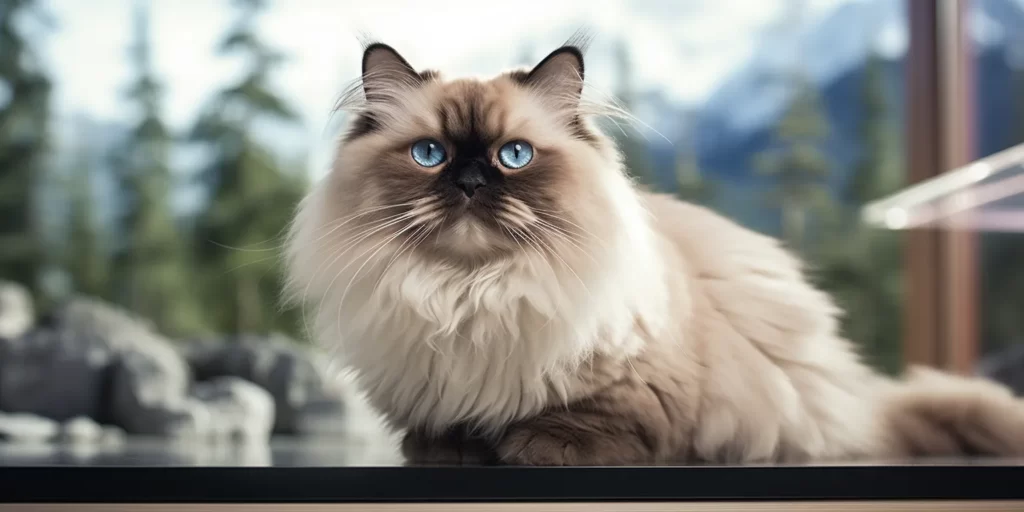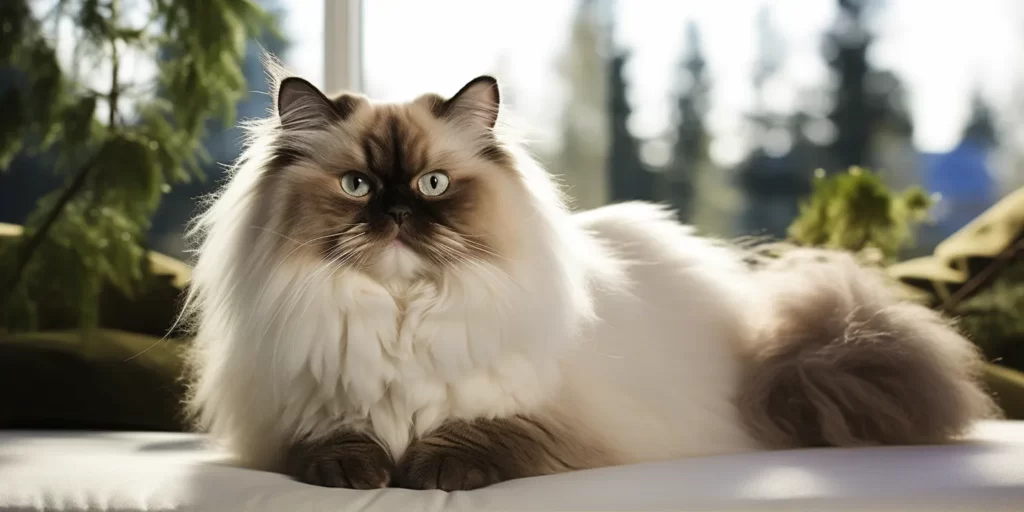The allure of the Himalayan cat, with its striking blue eyes and luxurious fur, is undeniable, and it comes as no surprise that this breed is a sought-after companion in households around the globe. As with any pet, potential owners must consider the associated costs, not just the initial price but the long-term financial commitment. In this comprehensive guide, we’ll break down everything you need to know about Himalayan cat prices and the cost of ownership, ensuring you’re fully informed before making this furry addition to your family in 2024.
Owning a Himalayan cat goes beyond its initial purchase; it’s a journey filled with affection and some expenses that prospective pet parents should prepare for. The unique characteristics of the breed, including its luxurious coat and amiable nature, contribute to both its charm and its price tag. Knowing what to expect financially secures a stress-free environment for both you and your Himalayan companion.
The cost of a Himalayan cat can vary widely, influenced by factors such as pedigree, age, and overall health. To navigate the intriguing world of cat companionship, one must be well-versed in not only the purchasing costs but also in the financial responsibility that accompanies raising a Himalayan cat. Let’s dive deep into what makes this breed so special and how its distinctive traits translate into cost.
- How Much Does a Himalayan Kitten Cost? $450 – $1500
- Other Factors That Influence the Purchase Price of a Himalayan Cat
- Initial Setup and Supplies Cost for Himalayan Cat
- The Ongoing Medical Expenses for the Himalayan Cat
- The Ongoing Food and Supplies Cost Of A Himalayan Cat
- How Much Does It Cost to Insure a Himalayan Cat?
- Additional Costs
- How To Save On The Ongoing Cost of Owning A Himalayan Cat
- How To Get a Himalayan on a Budget!
- Conclusion

How Much Does a Himalayan Kitten Cost? $450 – $1500
The price of a Himalayan kitten can vary significantly, typically ranging between $450 and $1500. This price variation is influenced by several factors, including the breeder’s reputation, the kitten’s lineage, and unique characteristics such as coat color and eye color.
Kittens from award-winning lineage or those that conform closely to breed standards may command higher prices.
Gender plays a surprisingly pivotal role in pricing. Male cats tend to be larger, potentially causing them to command a higher price point due to their robust appearance. In contrast, females might cost less but could incur additional expenses if you plan on breeding.
The color of a Himalayan is a feast for the eyes, ranging from deep blues to warm chocolates. These color variants are a result of meticulous genetic selection and breeding. Rare or highly sought-after colors often hike up the price due to their exceptional appeal.
Genetics not only affect color but also contribute to the cat’s lineage and potential show quality. Kittens from a line of award-winning ancestors or with the ideal breed traits can command top dollar. Therefore, prospective buyers looking for a pet-quality kitten might find more affordable options compared to those seeking show-quality felines.
Other Factors That Influence the Purchase Price of a Himalayan Cat
There are many elements that could lead to variations in the cost of acquiring your ideal Himalayan pet. Factors such as availability, breeding conditions, demand, and even regional economic trends can all influence the final price you might pay for this exotic companion.
Additionally, changes in transportation costs, regulatory measures, and veterinary healthcare advancements could also play a significant role in determining the overall expense involved in purchasing a Himalayan animal.

Age of The Himalayan Cat
Younger kittens tend to be more expensive due to their cuteness and the expectation that they will live longer, providing their owners with many years of companionship. In contrast, older cats may be less costly to adopt, but they could potentially lead to higher healthcare costs as they grow older and possibly develop more health issues.
Quality Of The Breed
Show-quality Himalayan cats, which adhere strictly to the breed’s standards and showcase its distinctive characteristics, can often be quite expensive. This high cost is attributed not only to their potential for success in competitive shows but also to their undeniable aesthetic appeal.
Even for those who do not wish to participate in cat shows, owning a top-tier example of the breed holds significant allure, which is clearly mirrored in the pricing of these elite animals.
Pattern, Color, Body Form
Details such as facial symmetry, the structure of the body, and the pattern of the coat significantly influence how an animal is priced. An animal that perfectly meets the breed standards, especially if it boasts an appealing or unusual coat pattern or color, can command a much higher price.
These features are highly prized as they conform closely to idealized standards, making such animals particularly desirable to buyers and collectors who seek premium specimens for breeding, shows, or as pets.

Genetics & Health of The Cat
Breeding cats with optimal genetic health through careful selection based on genetic profiles helps in reducing the risk of hereditary diseases. This approach ensures that kittens are healthier and less likely to suffer from genetic disorders, which can be expensive and emotionally challenging to treat.
These kittens, therefore, become more valuable to potential owners looking for a pet with a potentially longer, healthier life.
Also, kittens that have undergone extensive health checks and screenings from birth are pricier. This is because they are likely to have longer, healthier lives and could incur fewer medical expenses in the future.
Availability of The Cat Your Area
In regions where Himalayan cats are rare, their scarcity can significantly enhance their value. This breed, known for its striking appearance and docile temperament, becomes more desirable when fewer are available.
Consequently, if the demand for Himalayans persists or increases while the supply remains limited, prices for these cats are likely to rise. This economic principle of supply and demand affects not just commodities but also the pet market.
Potential cat owners seeking a Himalayan may find themselves facing higher costs or longer waits, which can further inflate the perceived value of these distinctive felines. Thus, in areas where Himalayans are few and far between, their rarity can make them particularly prized possessions.
Initial Setup and Supplies Cost for Himalayan Cat
Welcoming your new Himalayan starts with ensuring you have all the necessary supplies to provide a comfortable and stimulating environment.
| Type of Cost | Dollar Amount $ |
|---|---|
| Spay/Neuter: | $200 – $500 |
| Vet Exam and Shots: | $50 – $100 per visit |
| Microchip (recommended): | $40 – $60 |
| Cat Bed: | $20 – $50 |
| Nail Clipper (optional): | $10 – $25 |
| Brush (optional): | $10 – $30 |
| Litter Box: | $10 – $45 |
| Litter Scoop: | $10 – $25 |
| Toys: | $15 – $50 |
| Food and Water Bowls: | $10 – $30 |

The Ongoing Medical Expenses for the Himalayan Cat
Maintaining your Himalayan’s health with regular vet visits and preventative care is vital for a long and happy life. Vaccinations must be kept up to date to shield your pet from common diseases. Routine vet checkups will help catch any health issues early on, which can save money in the long run.
Flea and tick prevention is crucial, especially given the luxurious coat of a Himalayan cat that can provide a haven for pests. Medicines for any specific health concerns must also be factored into your budget as these breeds are prone to certain genetic conditions.
The Ongoing Food and Supplies Cost Of A Himalayan Cat
A nutritionally balanced diet tailored to their specific needs will contribute majorly to your Himalayan’s health. The type of food, whether dry kibble, canned food, or a raw diet, will influence ongoing costs.
Next come cat litter expenses plus occasional teeth cleaning sessions. Bedding and toys will also face wear and tear over time; thus replacements should be anticipated. Since sturdy grooming tools are a one-time investment, they aren’t included here.
How Much Does It Cost to Insure a Himalayan Cat?
Securing insurance policy for your Himalayan cat can be a prudent decision to help manage unforeseen veterinary costs arising from illnesses or accidents. The premiums for such insurance policies can differ significantly, depending on the level of coverage you choose, which might range from basic emergency care to comprehensive health plans that include regular check-ups and preventive care.
Additionally, these premiums are influenced by any pre-existing conditions your Himalayan may have, which could increase the cost. By investing in pet insurance, you can alleviate the financial burden of high medical bills, ensuring that your furry friend receives the necessary care without compromising due to cost concerns.
This peace of mind allows you to enjoy more quality time with your pet, knowing that you are prepared for potential health issues.
Additional Costs
Bearing in mind that cats may cause accidental damage like scratching furniture or requiring additional grooming supplies to maintain their coat can impact your budget. Carpet cleaning and perhaps even pet sitting services during vacations or unpredicted engagements add up too.
Lint or hair rollers for fur cleanup and possibly even small repairs for scratched clothing or shoes should also be considered when calculating the true cost of owning such an elegant breed as the Himalayan.
How To Save On The Ongoing Cost of Owning A Himalayan Cat
Owning a Himalayan cat can be a delightful experience, but it also comes with ongoing costs that can add up. To save money while ensuring your cat remains healthy and happy, consider the following strategies.
Firstly, prioritize preventive care by keeping up with regular veterinary check-ups and vaccinations, which can help avoid more costly health issues down the line.
Secondly, invest in high-quality cat food that meets the nutritional needs of a Himalayan; this might seem expensive initially but can prevent diet-related health problems in the future.
Additionally, grooming your Himalayan cat at home can significantly reduce costs. Regular brushing helps prevent matting and reduces the frequency of professional grooming sessions.
Lastly, consider purchasing pet insurance or setting aside a savings fund specifically for pet-related expenses. This can help manage unexpected costs more effectively, ensuring your pet’s needs are covered without breaking the bank.
How To Get a Himalayan on a Budget!
Adopting from shelters or rescues often results in reduced fees compared to purchasing from breeders. Platforms like Craigslist, Kijiji, Facebook Marketplace, or community boards might present opportunities to adopt at a lower cost or even free under certain circumstances.
Remember to factor in any potential hidden costs when acquiring a pet through these means as they may not have had the same level of veterinary care or pedigree certification.
Conclusion
Welcoming a Himalayan cat into your family is not just about enjoying their beautiful, fluffy appearance and affectionate nature; it also involves a commitment to their well-being and financial responsibility.
From initial costs like vaccinations, spaying/neutering, and essential supplies to ongoing expenses such as high-quality food, regular vet check-ups, and grooming, owning a Himalayan cat requires thoughtful financial planning.
By preparing for both the predictable and unexpected costs, you can ensure a stress-free environment for both you and your pet. This careful budgeting allows you to fully appreciate the deep bond and joyful moments with your Himalayan, making the investment in their health and happiness a truly invaluable part of your life.